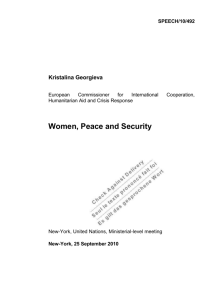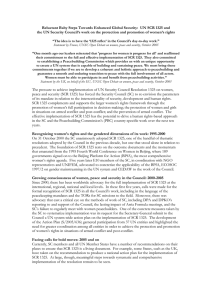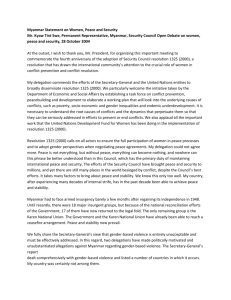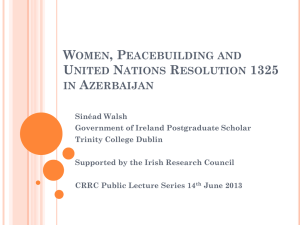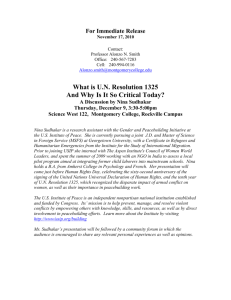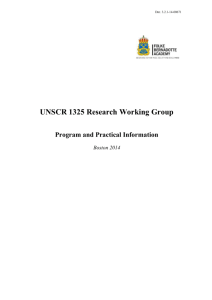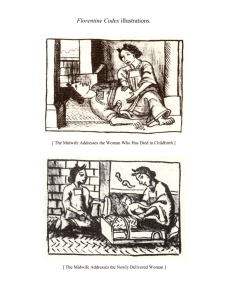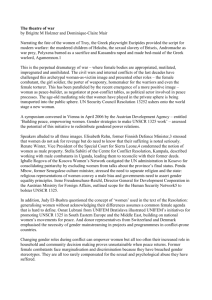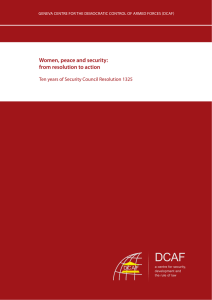Gender Training - NGO Working Group on Women, Peace and
advertisement
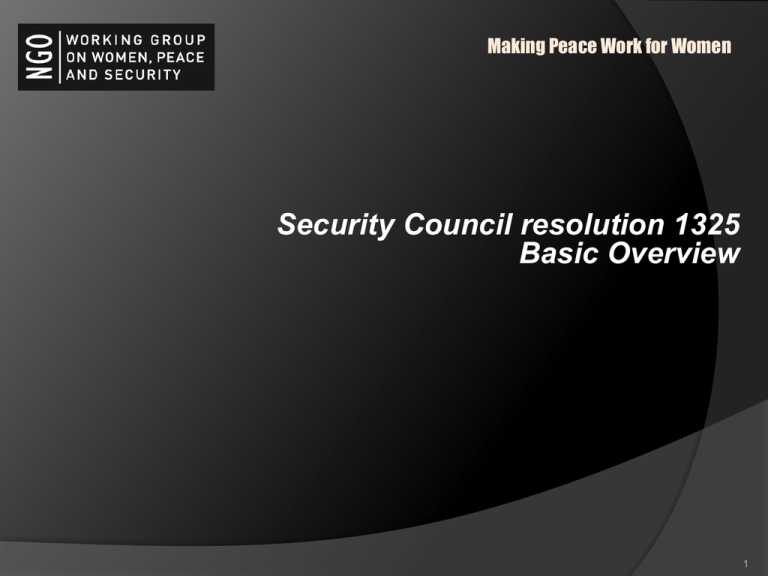
Making Peace Work for Women Security Council resolution 1325 Basic Overview 1 Learning Objectives • Strengthen understanding of the relevance of gender perspectives on peace and security. • Strengthen understanding of the content and purpose of SCR 1325. 2 What is Security? How do you define Security? 3 Human Security Framework Emphasis on protecting individuals, in terms of both freedom from fear and freedom from want This means safety from chronic or sudden threats including sexual violence, hunger, human rights abuses, disease and repression Human security should be linked to empowerment so that people are enabled to protect their own dignity, livelihood and survival 4 Importance of Women to Human Security The inclusion of women’s different life experiences, perspectives, priorities and participation in issues of Security helps to build sustainable peace and development 5 Consequences of Women’s Exclusion from Peace and Security Processes • Peace, development and reconstruction strategies are weakened. • Peace negotiations and accords are weakened. • National economies are weaker. 6 Women, Security & Peacebuilding Without public standing, including political participation, women cannot play a role in community building and conflict prevention. Without physical security and respect for human rights, women and girls may be vulnerable to sexual exploitation and unable to defend themselves against HIV/AIDS. Without economic security, women and girls cannot educate and empower their children. All of this threatens medium and long-term prospects for peace and development. 7 Gender Basics Definition of Gender : The term gender refers to the social differences between females and males throughout the life cycle that are learned, and though deeply rooted in every culture, are changeable over time and have wide variations both within and between cultures. “Gender” determines the roles, power and resources for females and males in any culture. 8 Introduction to SCR 1325 Security Council resolution 1325 was unanimously adopted on 31 October 2000 by the UN Security Council. Preceded by numerous resolutions, treaties, conventions, statements and reports. Part of a larger gender equality framework including: • The Convention on the Elimination of All Forms of Discrimination Against Women (CEDAW) • Beijing Declaration and Platform for Action (BPFA) 9 Implications SCR 1325 recognizes that men and women experience security differently and that to build sustainable peace women need to be fully involved. 10 What is the Security Council? Security Council’s primary responsibility is the maintenance of international peace and security: • Investigate disputes that might escalate to cause international tension; • Dispatch peacekeeping operations; • Impose economic sanctions; • Mandate arms inspections; • Deploy human rights and election monitors; • Refer situations to the International Criminal Court. 11 1325 Key Elements • Women’s Participation • Protection of Women and Girls • Gender Training • Inclusion of Gender Perspectives • Prevention 12 Who is Responsible for Implementation? • Security Council • Secretary General • UN Agencies • Member States • All parties to armed conflict 13 Is SCR 1325 Legally Binding? Article 25 of the United Nations Charter requires Member States to carry out all decisions of the Security Council 14 1325 Key Elements • Women’s Participation • Protection of Women and Girls • Gender Training • Inclusion of Gender Perspectives • Prevention 15 Women’s Participation The Resolution reaffirms “the important role of women in the prevention and resolution of conflicts and in peace-building, and stressing the importance of their equal participation and full involvement in all efforts for the maintenance and promotion of peace and security […]”. Preamble Provisions: 1, 2, 3, 4 Examples • Increasing the number of women in decision making • Nominating women as representatives • Ensuring women’s involvement in peace negotiations • Consulting with women’s and women’s organizations 16 Protection of Women & Girls The resolution reaffirms “the need to implement fully international humanitarian and human rights law that protects the rights of women and girls during and after conflicts […]” (Articles: 9, 10, 11) Examples • Including human trafficking as an issue in determining boarder protection policies • Training police on how to respond to domestic violence • Including sexual violence in any reparations or peace negotiations discussions 17 Gender Training The resolution urges “Member States to increase their voluntary financial, technical and logistical support for gender sensitive training efforts […]” (Articles: 6, 7) Examples: • Gender training incorporated into national training programs • Producing gender-sensitive training methods and tools 18 Inclusion of Gender Perspectives The resolution recognises « the urgent need to mainstream a gender perspective into peacekeeping operations [...] » (Articles: 5, 8, 13, 14, 15, 16, 17) Examples: Gender perspective in Security Council missions Gender language in peacekeeping mission mandates Gender perspectives as a requirement for funding 19 Prevention The resolution reaffirms “the important role of women in the prevention and resolution of conflicts and in peacebuilding […]”(Articles: 1) Examples: • Women can play an important role in early warning • Defusing tensions and likelihood of conflict at community-level 20 Progress Implementing SCR 1325 Increased awareness. Increased representation of women in decision-making Increased institutional commitment to SCR 1325 at national, regional and international levels. More systematic attention to women, peace and security issues by UN, Member States and civil society. 21 Gaps and Challenges • Lack of accountability mechanisms • Women and gender issues still not seen as central to peace and security policy • Those in leadership positions have not been successfully engaged • Too little coordination and cooperation between different institutions 22
